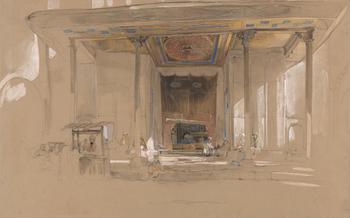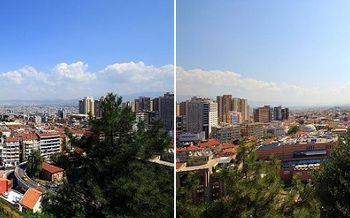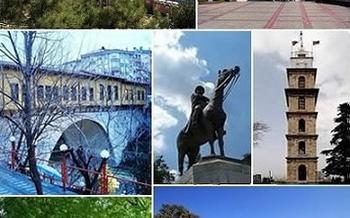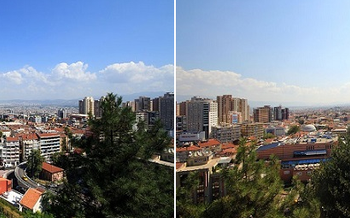
Gölyazı Archaeological Site
- Gölyazı Archaeological Site: A Hidden Gem in Bursa
- Location and Accessibility
- History of the Site
- Excavations and Discoveries
- Architectural Remains and Features
- Mosaics and Frescoes
- Pottery and Artifacts
- Religious and Ritual Practices
- Urban Planning and Infrastructure
- Economic Activities and Trade
- Daily Life and Social Structure
- Challenges and Threats to the Site
- Current Research and Future Prospects
- Visiting the Gölyazı Archaeological Site
- Insider Tip: Explore the Hidden Gem of the İznik Museum
Gölyazı Archaeological Site: A Hidden Gem in Bursa
Nestled in the picturesque province of Bursa, Turkey, lies the Gölyazı Archaeological Site, a treasure trove of ancient history and cultural significance. Its origins can be traced back to the 4th millennium BC, making it a true testament to the region's rich and diverse past. Excavations conducted at the site have unearthed remarkable artifacts and structures, providing valuable insights into the lives and traditions of the civilizations that once thrived here.
Gölyazı stands out for its unique features, including well-preserved mosaics and frescoes that adorn the ruins, offering a glimpse into the artistic prowess of ancient civilizations. The site also boasts an impressive collection of pottery and other artifacts, shedding light on the daily lives and economic activities of its inhabitants. With its historical significance and captivating ruins, Gölyazı promises an immersive journey into the past, making it a must-visit destination for history enthusiasts and culture seekers alike.
Location and Accessibility
The Gölyazı Archaeological Site is situated in the Gemlik district of Bursa, approximately 35 kilometers southwest of the city center. Its exact coordinates are 40°26'40"N 28°46'40"E. To reach the site, visitors can take public transportation options such as buses or taxis from Bursa city center, which offer convenient and affordable transportation. Alternatively, those traveling by car can find ample parking space available near the site.
History of the Site
In the fertile plains of Bursa, where the past whispers secrets beneath the soil, lies the Gölyazı Archaeological Site. This ancient settlement, dating back to the 2nd millennium BC, has yielded a wealth of artifacts and evidence that illuminate the lives of long-lost civilizations.
Excavations have revealed traces of various cultures that once called this place home. The Phrygians, with their enigmatic language and rich mythology, are believed to have been among the earliest inhabitants. Their presence is attested by distinctive pottery and architectural remains that speak of their unique cultural identity.
As centuries passed, the site witnessed the rise and fall of different civilizations. Hellenistic influences left their mark in the form of exquisite mosaics and frescoes, while the Romans, with their prowess in engineering and administration, shaped the urban landscape. Each civilization that graced this land left behind a tapestry of artifacts and architectural remnants, creating a rich historical mosaic that invites exploration and interpretation.
Excavations and Discoveries
Archaeological excavations at the Gölyazı Archaeological Site began in the early 20th century and have continued intermittently since then. The site has yielded a wealth of significant discoveries, including artifacts, building remains, and artwork that shed light on the ancient civilizations that inhabited the area.
One of the most important discoveries was a series of well-preserved mosaics and frescoes depicting scenes from mythology and everyday life. These artworks provide valuable insights into the artistic traditions and beliefs of the ancient inhabitants. Another significant find was a large number of pottery fragments and other artifacts, which have helped archaeologists reconstruct the daily lives and economic activities of the ancient city.
The excavations have also revealed the remains of several buildings, including a temple, a theater, and a bathhouse. These structures provide evidence of the city's urban layout and infrastructure and suggest that it was a thriving commercial and cultural center in ancient times.
The discoveries made at the Gölyazı Archaeological Site have contributed significantly to our understanding of ancient civilizations in the region. They have provided new insights into the artistic, religious, and economic practices of these societies and have helped to shed light on the development of urban centers in the ancient world.
Architectural Remains and Features
The visible ruins and structures at the Gölyazı Archaeological Site offer a glimpse into the architectural prowess and ingenuity of its ancient inhabitants. The site features a variety of well-preserved buildings, including residential structures, public buildings, and religious edifices. These structures showcase a combination of local building traditions and influences from neighboring civilizations.
The building materials used at the site include stone, brick, and mudbrick. Stone was primarily employed for foundations and lower walls, while brick and mudbrick were utilized for upper walls and interior partitions. The use of arches and vaults demonstrates the advanced engineering skills of the ancient builders.
Distinctive architectural features include intricate stone carvings, decorative moldings, and colorful frescoes. These decorative elements add a touch of elegance and artistry to the otherwise utilitarian structures. The site also features a well-preserved water cistern, which testifies to the importance of water management in ancient times.
The architectural remains at Gölyazı provide valuable insights into the urban planning and daily life of its inhabitants. The orderly layout of the streets and buildings suggests a well-organized and efficient city. The presence of public buildings, such as a theater and a bathhouse, indicates the existence of a vibrant community life.
Mosaics and Frescoes
The Gölyazı Archaeological Site is home to a remarkable collection of mosaics and frescoes, which are considered among the finest examples of Byzantine art in Turkey. These artworks depict a variety of themes and motifs, including religious scenes, mythological figures, and everyday life. The mosaics are particularly impressive, showcasing intricate designs and vibrant colors that have been remarkably well-preserved over the centuries.
The techniques and materials used in the creation of these mosaics and frescoes are also noteworthy. The artists employed a combination of tesserae, or small pieces of colored glass or stone, and fresco painting, which involves applying pigments to wet plaster. The resulting artworks are characterized by their realism, expressiveness, and attention to detail, providing valuable insights into the artistic and cultural traditions of the Byzantine Empire.
The conservation of these mosaics and frescoes presents significant challenges, as they are susceptible to damage from environmental factors, humidity, and human activities. Ongoing efforts are underway to protect and preserve these precious artworks, ensuring that they remain accessible to visitors and future generations.
Pottery and Artifacts
The Gölyazı Archaeological Site has yielded a rich collection of pottery and other artifacts that provide valuable insights into the daily life and artistic traditions of its ancient inhabitants. These artifacts include a diverse range of ceramic vessels, such as amphorae, jugs, plates, and bowls. The pottery is often decorated with intricate patterns and motifs, including geometric designs, floral motifs, and human figures. Some of the pottery also bears inscriptions, providing further clues about the site's history and inhabitants.
In addition to pottery, archaeologists have also discovered a variety of other artifacts at the site, including tools, weapons, jewelry, and religious objects. These artifacts are made from a variety of materials, including bronze, iron, bone, and stone. The tools include axes, hammers, chisels, and knives, which suggest that the inhabitants of the site were engaged in a variety of activities, such as woodworking, metalworking, and agriculture. The weapons include swords, spears, and arrowheads, indicating that the inhabitants were also prepared for warfare. The jewelry includes necklaces, bracelets, and earrings, which provide evidence of the inhabitants' personal adornment and artistic skills.
The pottery and artifacts found at the Gölyazı Archaeological Site are not only beautiful works of art but also valuable sources of information about the daily life and culture of the ancient inhabitants. These artifacts provide a tangible connection to the past and help us to understand the lives of the people who lived in this region centuries ago.
Religious and Ritual Practices
In addition to its architectural remains and artifacts, the Gölyazı Archaeological Site provides evidence of religious activities and rituals practiced by its ancient inhabitants. There are several structures and objects that suggest the presence of religious beliefs and practices at the site. These include temples, altars, and various religious symbols and figurines.
The temples at Gölyazı were likely used for worship, offerings, and other religious ceremonies. They are typically decorated with intricate carvings and sculptures depicting various deities and mythological scenes. The altars, on the other hand, were used for making offerings and sacrifices to the gods. They are often found in close proximity to the temples and may have been used for specific rituals or ceremonies.
Among the most intriguing religious artifacts found at the site are the numerous figurines and statuettes depicting various deities and mythical creatures. These figurines may have been used as objects of worship or as representations of the gods and goddesses in religious rituals. They provide valuable insights into the religious beliefs and practices of the ancient inhabitants of Gölyazı.
The evidence of religious activities and rituals at the Gölyazı Archaeological Site sheds light on the spiritual and cultural life of its ancient inhabitants. It suggests that religion played an important role in their daily lives and that they had a rich and complex system of beliefs and practices.
Urban Planning and Infrastructure
The Gölyazı Archaeological Site reveals a sophisticated urban plan and infrastructure that reflects the advanced level of civilization in the region. The city was laid out on a grid system, with streets intersecting at right angles to form regular blocks. The ruins of various buildings, including houses, shops, and workshops, can be seen throughout the site, providing insights into the daily life and economy of the ancient inhabitants.
One of the most impressive features of the site is its water management system. A complex network of underground channels and reservoirs ensured a steady supply of water to the city. These channels also served as a drainage system, preventing flooding and maintaining a clean and healthy environment.
The site also boasts several public buildings, such as a theater and a bathhouse, which indicate the importance of civic life and leisure activities. The theater, with its well-preserved stage and seating area, could accommodate over a thousand spectators, suggesting the popularity of theatrical performances in ancient times. The bathhouse, with its intricate heating system and mosaic floors, provides further evidence of the luxurious lifestyle enjoyed by the city's inhabitants.
Economic Activities and Trade
The Gölyazı Archaeological Site reveals a vibrant economic landscape that extended beyond its immediate surroundings. Evidence suggests that the ancient inhabitants engaged in a diverse range of economic activities, including agriculture, trade, and manufacturing. The presence of agricultural tools and storage facilities indicates that farming was a primary livelihood, with crops such as wheat, barley, and grapes being cultivated.
Trade played a significant role in the economic prosperity of the site. Its strategic location along trade routes facilitated the exchange of goods with neighboring regions and distant lands. Excavations have uncovered a variety of imported goods, including pottery, jewelry, and glassware, indicating the site's participation in extensive trade networks.
The Gölyazı Archaeological Site also served as a manufacturing center. Workshops and kilns discovered at the site suggest that the ancient inhabitants produced their own pottery, textiles, and metal objects. These goods were likely traded or sold locally, contributing to the site's economic vitality.
The economic activities at the Gölyazı Archaeological Site provide valuable insights into the daily life and social structure of its ancient inhabitants. The presence of diverse economic pursuits suggests a complex and organized society, with different individuals and groups specializing in specific trades and occupations. The site's role as a trading hub further demonstrates its importance as a regional center of commerce and cultural exchange.
Daily Life and Social Structure
The Gölyazı Archaeological Site offers valuable insights into the daily life and social structure of its ancient inhabitants. Excavations have revealed evidence of well-organized residential areas, suggesting a settled and structured community. The presence of communal spaces, such as courtyards and public buildings, indicates a sense of community and social interaction.
The site also provides clues about the social hierarchy and class divisions that existed within the society. Different types of housing structures, ranging from simple dwellings to more elaborate and spacious ones, suggest the presence of social stratification. The discovery of imported goods and luxury items hints at a wealthy elite class that engaged in trade and commerce.
The Gölyazı Archaeological Site offers a glimpse into the customs, traditions, and daily routines of its ancient inhabitants. Evidence of cooking utensils, storage jars, and agricultural tools provides insights into their subsistence strategies and culinary practices. The presence of personal items, such as jewelry, mirrors, and combs, sheds light on their grooming habits and fashion sense.
By examining the remains of the Gölyazı Archaeological Site, we can piece together a comprehensive picture of the daily life and social structure of the ancient civilization that once thrived in this region. It is a testament to the complexity and sophistication of their society, offering valuable insights into the human experience in a bygone era.
Challenges and Threats to the Site
The Gölyazı Archaeological Site faces several challenges and threats that jeopardize its preservation and integrity. Environmental factors, such as erosion and natural disasters like earthquakes, pose a significant risk to the site's structures and artifacts. Human activities, including looting and vandalism, further contribute to the site's deterioration.
Looting has been a persistent problem at Gölyazı, with individuals illegally excavating and removing valuable artifacts from the site. This not only deprives future generations of the opportunity to study and appreciate these artifacts but also damages the archaeological context and integrity of the site.
To address these challenges, comprehensive conservation and preservation efforts are underway. The Turkish government, in collaboration with local authorities and international organizations, has implemented measures to protect the site and its artifacts. These measures include increased surveillance, the establishment of a buffer zone around the site, and the implementation of strict regulations against looting and vandalism.
Public awareness campaigns have also been launched to educate local communities about the importance of preserving the site and its cultural heritage. By raising awareness and fostering a sense of ownership among the local population, the authorities aim to reduce the risk of looting and vandalism and encourage community involvement in the site's preservation.
Ongoing research and excavations are carefully planned and executed to minimize any potential damage to the site's structures and artifacts. Archaeologists employ non-invasive techniques and adhere to strict ethical guidelines to ensure the preservation of the site's integrity and historical significance.
Current Research and Future Prospects
The Gölyazı Archaeological Site continues to be a rich source of new discoveries and insights. Ongoing archaeological research and excavations are shedding light on the site's complex history and significance. Future research is expected to yield even more valuable information, including new artifacts, structures, and inscriptions.
One of the most exciting prospects for the future of the site is its potential to become a major tourist attraction and heritage site. With its unique and well-preserved ruins, the site has the potential to attract visitors from around the world. This would not only boost the local economy but also raise awareness of the site's historical and cultural importance.
To realize this potential, collaboration with other institutions and experts is essential. This could include partnerships with universities, museums, and international organizations. By working together, these entities can enhance research and preservation efforts, develop educational programs, and promote the site to a wider audience.
The Gölyazı Archaeological Site has the potential to become a major player in the world of archaeology and cultural heritage. With ongoing research, collaboration, and preservation efforts, the site can continue to reveal its secrets and provide valuable insights into the past.
Visiting the Gölyazı Archaeological Site
Practical Information: To visit the Gölyazı Archaeological Site, plan to arrive during its opening hours, typically from 8:30 AM to 5:30 PM. Admission fees are minimal, and guided tours are available for a more in-depth experience. The site is well-maintained, with designated paths and signage, but remember to wear comfortable shoes as the terrain can be uneven in places.
Exploring the Site: Take your time to explore the various sections of the site, admiring the well-preserved ruins and imagining the bustling life that once took place here. Marvel at the intricate mosaics and frescoes, which provide valuable insights into the artistic and cultural traditions of the ancient inhabitants. Don't miss the pottery and artifacts on display, which offer a glimpse into their daily lives and economic activities.
Combining Attractions: Combine your visit to the Gölyazı Archaeological Site with other nearby attractions to make the most of your time in Bursa. Consider visiting the nearby Mudanya district, known for its charming waterfront and historic buildings. You can also explore the city center of Bursa, with its vibrant markets, mosques, and museums, including the Bursa Grand Mosque and the Bursa Museum.
Accessibility and Special Needs: The Gölyazı Archaeological Site is generally accessible for visitors with disabilities, although some areas may require assistance. Wheelchairs can navigate the main paths, and there are ramps and elevators to access certain sections of the site. If you have any special needs or concerns, don't hesitate to inquire with the site staff or tour operators for assistance.
Insider Tip: Explore the Hidden Gem of the İznik Museum
As you delve into the history of Bursa and its surroundings, don't miss the opportunity to visit the İznik Museum, located just a short distance from the Gölyazı Archaeological Site. This hidden gem houses a remarkable collection of artifacts and artworks that provide a glimpse into the rich cultural heritage of the region.
The museum showcases a stunning array of İznik ceramics, renowned for their intricate designs and vibrant colors. These exquisite pieces, produced during the Ottoman Empire, are considered masterpieces of Islamic art. Admire the intricate patterns, vibrant hues, and unique motifs that adorn these ceramic tiles, plates, and vessels.
In addition to the ceramics, the museum exhibits a diverse range of artifacts, including ancient coins, jewelry, sculptures, and tools. These relics offer valuable insights into the daily life, customs, and beliefs of the people who inhabited this region throughout history. Take your time to explore the various galleries and immerse yourself in the captivating stories they tell.
After your visit to the İznik Museum, savor the flavors of traditional Turkish cuisine at one of the local restaurants in the area. Indulge in delectable dishes prepared with fresh, local ingredients, and experience the warm hospitality of the Turkish people.
Remember, the true beauty of travel lies in uncovering hidden gems like the İznik Museum. Embrace the opportunity to explore beyond the beaten path and discover the unique treasures that await you in Bursa.









